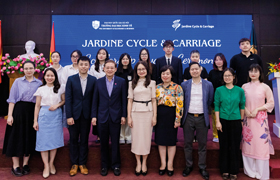Sustainability Report 2023 Summary
Read moreJC&C has a robust governance structure to ensure effective management of sustainability issues, with the Board of Directors (the “Board”) maintaining the highest level of oversight. Annually, the Board re-evaluates and endorses the material Environmental, Social and Governance (“ESG”) topics to ensure their integration into the Group’s overarching strategy and portfolio management. The Board oversees the management and monitoring of these material ESG topics and is responsible for JC&C’s sustainability reporting. The Board-level Audit & Risk Committee (“ARC”) oversees all risks, including ESG and climate-related concerns. The Board meets five times a year and sustainability is a recurring agenda item for every meeting.

The Executive Committee (“Excom”), or JC&C’s leadership team, shapes the overall sustainability strategy. By setting the ESG agenda and incorporating relevant elements into annual budget discussions and long-term planning, the Excom ensures that sustainability goals are aligned with performance objectives. Furthermore, the Excom ensures that all new investments or significant capital expenditures undergo a sustainability analysis, with due diligence reports reviewed by the Board. As part of JC&C’s sustainability commitment, ESG considerations influence management’s performance incentives, particularly for our top ESG material topics highlighted in the Double Materiality Matrix on page 60.
A cross-functional Sustainability Committee comprising Excom members and Heads of Function, meets quarterly to set goals, plan initiatives and develop action plans. These plans are operationalised and executed by the Sustainability Working Group, a diverse team of employees from various levels and functions who meets monthly to discuss issues, implement strategy and monitor trends.
The ESG & Sustainable Development department reports directly to the Group Managing Director and coordinates sustainability initiatives across the Group. This team collaborates with internal functions as well as portfolio company-level sustainability teams, providing strategic ESG guidance for decision making. The department is also responsible for the consolidation of ESG data and reporting efforts. For a detailed description of Corporate Governance at JC&C, please refer to pages 32 to 57.
Our Sustainability Framework
Rooted in the principles of good governance and transparency, our sustainability framework is a comprehensive approach that empowers us to strive for our 2030 goals and create evermore opportunities for our many stakeholders in the region. It is driven by a steadfast commitment to safeguard shareholder value, uphold ethical practices and embrace a forward-thinking mindset.
With long-term strategic planning, responsible resource management and targeted investments in individual and societal growth, we maintain our social license to operate while enhancing the long-term resilience of our businesses and profits. The framework incorporates portfolio decarbonisation and profit rebalancing, strategically adapting our operations to transition towards a low-carbon future.
Moreover, our commitment to social responsibility is an integral part of our sustainability strategy. By actively engaging in initiatives that positively impact our communities and aligning our efforts with the United Nations’ Sustainable Development Goals (“UN SDGs”), we aim to foster meaningful avenues for positive change, with an emphasis on areas such as mental health and education.
We firmly believe in sustainable business practices – that our success is intertwined with the well-being of the communities we serve. With investments in established market-leading businesses of Southeast Asia, our sustainability framework aims to support building resilience in our portfolio businesses while creating positive change.
Our Sustainability Progress
In 2023, we made advances towards our long-term ambitions and tar gets.
-
Over
US$1 BILLION
invested towards low-carbon transition since 2019
-
Almost
360MW
of additional renewables capacity generated since 2019
-
Over
10%
reduction in Scope 1 and 2 absolute emissions from 2019 baseline
-
Over
40%
of energy consumption derived from renewable sources in 2023
-
Over
98%
of solid waste diverted in 2023
-
15%
reduction in water withdrawal intensity from 2019 baseline
-
54%
female representation in management at JC&C head office in 2023
-
Over
S$722,000
pledged to MINDSET since 2019
-
33
scholarships awarded since 2019
Our ESG Materiality Approach
We review and validate our material ESG topics annually. Our approach to assessing materiality is presented below.
-
Determine a comprehensive list of ESG matters that are potentially relevant to JC&C’s strategy and business activities, based on peers, parent and portfolio companies, sustainability standards and frameworks, regulations, megatrends and external reports on JC&C.
-
Rank the proposed material topics based on their impact to JC&C’s businesses as well as to the environment and society, according to the findings from the stakeholder engagement.
-
Review the prioritised topics from Step 2 and seek approval from the Board.
-
Integrate the approved material ESG topics into the business strategy and ensure management of performance.
In 2023, we conducted a comprehensive materiality assessment, applying the concept of double materiality1 to re-evaluate ESG material topics crucial to both internal and external stakeholders. Representatives from six key stakeholder groups rated potential topics based on their impact to JC&C’s businesses as well as to the environment and society. The scores from each topic were calculated as weighted averages and charted into the Double Materiality Matrix (Figure 2). In addition to identifying the ESG topics most material to JC&C, our 2023 stakeholder engagement efforts identified three “topics of ongoing importance”, which now incorporates GRI 205: Anti-Corruption.
1 We considered the impact materiality (our businesses’ actual and potential impact on the environment or society) as well as the financial materiality (the topics’ actual and potential impact on JC&C’s enterprise value).

Figure 2: Double materiality matrix


